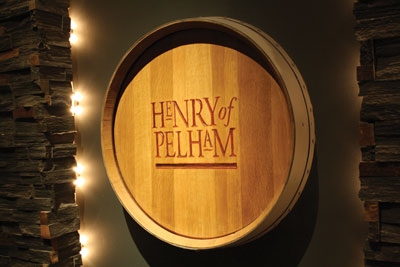
Features
Production
Profiles
Growing vinifera Henry of Pelham style
November 6, 2012 By Dan Woolley
 Matthew and his brothers, Daniel and Paul, grow grapes on 170 acres. Their family first planted vines in 1984. They now produce about 90,000 cases of Vintners Quality Alliance (VQA) wine annually at Henry of Pelham Winery. Danielle Scott
Matthew and his brothers, Daniel and Paul, grow grapes on 170 acres. Their family first planted vines in 1984. They now produce about 90,000 cases of Vintners Quality Alliance (VQA) wine annually at Henry of Pelham Winery. Danielle ScottIt is a risky business operating a vineyard in a cool climate, according to Matthew Speck, vice-president of viticulture at Henry of Pelham Family Estate Winery in St. Catharines, Ont.
“You need a business plan for a vineyard and winery that works,” he advised those attending the Atlantic Canada Wine Symposium held recently in Halifax, N.S.
Matthew and his two brothers, Daniel and Paul, grow grapes on 170 acres. Their family first planted vines in 1984. They now produce about 90,000 cases of Vintners Quality Alliance (VQA) wine annually with about half of their wine grapes supplied by other Niagara Peninsula growers.
“You have no choice but to manage risk,” said Speck. “A business needs stability. The key to long-term success is to optimize your strength while minimizing weaknesses.
“You must understand the business of cool climate to realize your opportunities,” he stressed.
While all Canadian regions could be considered cool climate viticulture regions, the opportunities for viticulture are best in areas that produce aromatic wines with a fresh, fruit-forward taste and a balanced finish, said Speck.
Their greater acidity also allows for a range of wine styles from dry to sweet, he said, noting wines that express their place of origin – terroir – will be sought by consumers who want those characteristics.
Cool climate viticulture has its particular challenges, he conceded, with variable rainfall, variable temperatures, variable crop sizes – all due mainly to variable winter conditions.
In Canada, grape growing’s limiting parameters are related to climate, not soils, said Speck.
“To manage a vineyard effectively, we need to know what the climatic extremes are and how often they occur,” he said.
“What are the prevailing winter temperatures and how many frost-free days and how often do they occur?”
Growers must understand these factors at a regional level. Even more importantly, they must understand the nature of the climate in their vineyard over a 10-year minimum period “to plan for those once in 10 years climate events,” said Speck.
Regional data is not a substitute for microclimate data as grape varieties will perform differently at different spots in the vineyard, he said.
As an example, in the Henry of Pelham vineyard, Speck has noticed Baco Noir is perfect in a low spot while Merlot performs well in higher areas.
“You need all your vines producing well,” he said. “You need to get production as even as possible between all your vines.
Plant the right varieties in the right places, or it won’t pay its way.”
A vineyard “is not a high margin business,” said Speck. “Therefore, the most important piece of equipment in the vineyard is its weather station. You can’t run an efficient vineyard without it.”
To help with cold weather and late frosts, Henry of Pelham uses wind machines.
“Wind machines are very useful on a cold night,” said Speck. “They will warm up the vineyard by a few degrees and that can make all the difference.”
“We try and delay winter pruning as late as possible,” said Speck.
Mechanical pre-pruning helps to speed up the pruning process. Speck recommends both the hardiest vines as well as the weakest should be pruned. Leave twice the required number of buds until the final threat of frost has passed, he said, then cut off the extra canes.
Speck recommends managing rainfall on the vineyard by cultivating every second row while draining heavy soils to push roots in the row deeper into the soil. The goal is to have a full canopy along the row trellis.
Speck likes to have two trunks per vineyard row and he suggested growers leave excessive grapes on the vine, reducing them as the growing season advances. The objective is to convert “grapes to wines to dollars,” he said.
Reducing a vineyard’s crop load will produce better quality grapes and obtain a higher price, post harvest, per bottle, said Speck.
“The character and quality of wines start in the vineyard and they are captured in the winery,” he said. “Your cost structure – what you must charge for wine – is determined in the vineyard.”
The cost of the wine and its quality derives from the vineyard with the wine’s cost, plus the grower’s equity in his vineyard, driving the wine’s retail price, Speck explained.
A vineyard, therefore, must be operated separately from its associated winery, he asserted.
“We operate with two different sets of balance sheets.”
Lightly managed varietal rows earn $2.00 per kilogram of grapes when sold to a winery while more intensively cultivated Estate Tier rows receive $3.50 per kilogram to pay for the extra grapes that were thinned before harvest and the extra management and higher production costs for the Estate Tier row, Speck explained.
Variability of grape supply and wine vintage are a given, he said, noting the winery will respond through inventory management, carrying juice inventory in bulk tank storage, bottling the wine as close as possible to when it is needed for the market.
Try not to store wine in bottle for more than 12 months, Speck suggested. Instead, match vineyard production to what the market needs by outsourcing production.
Everyone in the secondary bulk market is either a buyer or a seller of wine, Speck observed.
“In Niagara you have Custom Vintners and the Niagara Wine Exchange that help everyone manage their inventory,” he said. “It is the most expensive part of winery management.”
Print this page